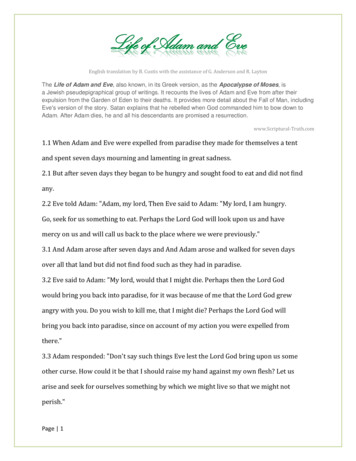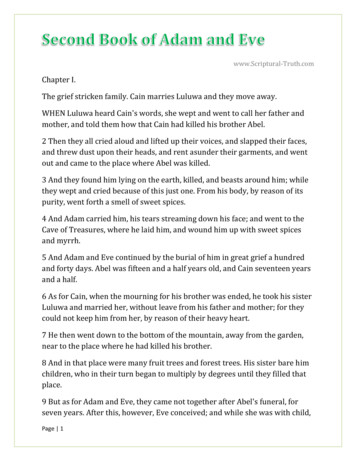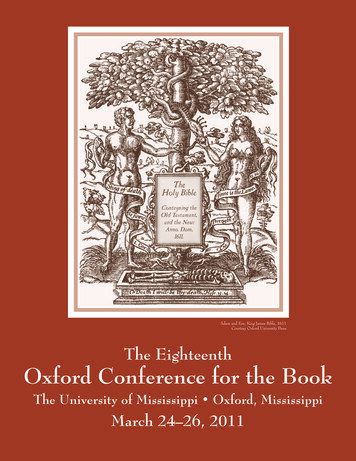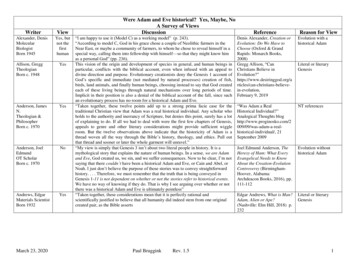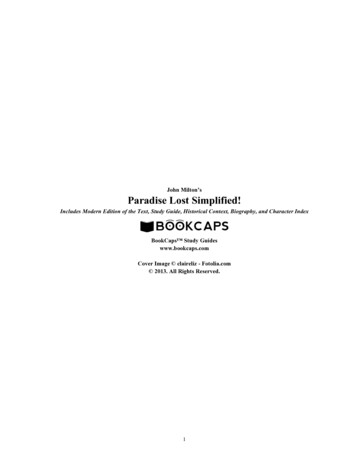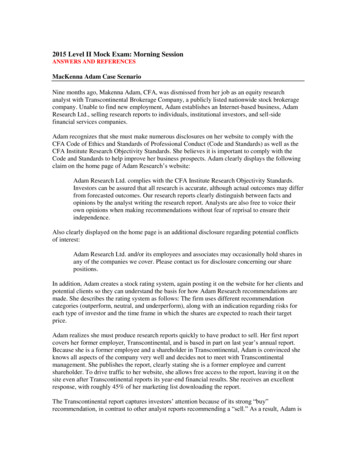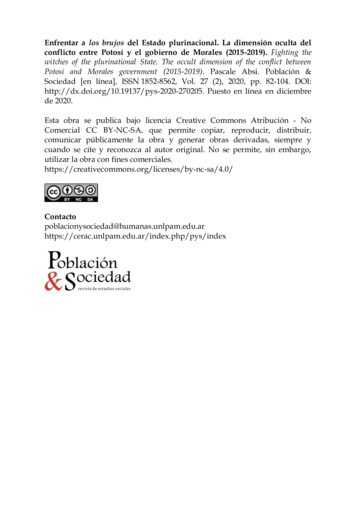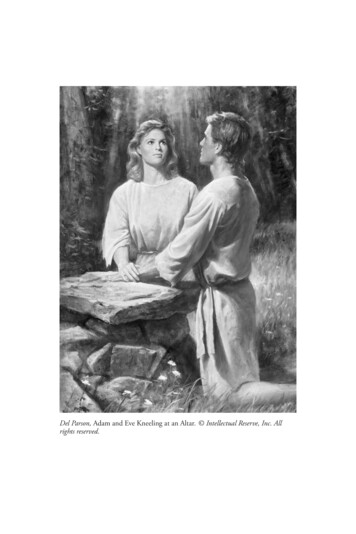
Transcription
Del Parson, Adam and Eve Kneeling at an Altar. Intellectual Reserve, Inc. Allrights reserved.
Daniel JuddThe Fortunate Fallof Adam and EveSome believe Adam and Eve’s partaking of the fruit of “the tree of knowledge ofgood and evil” (Genesis 2:9) to be the cause of all that is evil and tragic in theworld today. Others believe our first parents merely to be mythical beings whoseexistence is only a metaphor used to explain mankind’s existence. The doctrinesof the restored gospel concerning the historical reality of Adam and Eve and thedoctrine of the Fall provide a wealth of understanding concerning the purposesof adversity and opposition and the vital need for the Atonement of Jesus Christ.The doctrine of The Church of Jesus Christ of Latter-day Saintsconcerning the Fall of Adam and Eve is both distinctive andmeaningful. While including some similarities with the teachings ofother faiths, the Latter-day Saint doctrine of the Fall provides anunparalleled context for understanding key theological constructssuch as the nature of man, free will, the purposes of suffering andopposition, physical and spiritual death, and most importantly theAtonement of Jesus Christ. Understanding this fundamental doctrine also provides insight into what philosophers have termed “theproblem of evil,” which addresses the question of why God allowsevil and tragedy. This chapter articulates the doctrine of the Fall bycomparing Latter-day Saint theology with the teachings of otherChristian faiths.
Daniel K JuddT e Fortunate FallJacob Boehme, a sixteenth-century Christian theologian and philosopher, described the Fall as “the horrible, lamentable and miserable fall of Adam and Eve.”1 Although Boehme’s description ofthe Fall was written hundreds of years ago, it is still representativeof the current view held by much of traditional Christianity. Mostreligions, especially creedal Christianity, believe and express the ideathat “there was nothing fortunate about the fall of man. It was a totaltragedy for God and man.”2Latter-day Saints embrace the doctrine of the Fall as taught bylatter-day prophets as a restoration of one of the “plain and precious”(1 Nephi 13:28) principles that had been lost to mankind throughapostasy. Latter-day prophets acknowledge that “Adam’s fall was astep downward ” but teach that “it was also a step forward . . . inthe eternal march of human progress.”3 Latter-day leaders have alsotaught that mankind “should rejoice with [Adam and Eve], thatthrough their fall and the atonement of Jesus Christ, the way of eternal life has been opened up to us.”4 Instead of disdainfully looking atthe Fall as a tragedy, Latter-day Saints believe Adam and Eve’s eatingfrom “the tree of the knowledge of good and evil” (Genesis 2:17) tobe one of the most theologically significant and fortunate events inhuman history. While many condemn Adam and Eve for what theybelieve was their sin in the Garden of Eden and for the depravityof man that followed, Latter-day Saints reverence the choice madein Eden. Elder James E. Talmage stated, “It has become a commonpractice with mankind to heap reproaches upon the progenitors ofthe family, and to picture the supposedly blessed state in which wewould be living but for the fall; whereas our first parents are entitledto our deepest gratitude for their legacy to posterity—the means ofwinning title to glory, exaltation, and eternal lives.”5The Book of Mormon prophet Lehi recorded, “Adam fell that menmight be; and men are, that they might have joy” (2 Nephi 2:25).Lehi also taught, “If Adam had not transgressed he would not have300
The Fortunate Fall of Adam and Evefallen” (2 Nephi 2:22), and he and Eve “would have had no children. . . [and] no joy, for they knew no misery” (2 Nephi 2:23). Latterday scripture also contains the testimonies of Adam and Eve concerning their fall from innocence. Adam recorded, “Blessed be thename of God, for because of my transgression my eyes are opened,and in this life I shall have joy, and again in the flesh I shall see God”(Moses 5:10). Eve also testified, “Were it not for our transgression weshould never have had seed, and never should have known good andevil, and the joy of our redemption, and the eternal life which Godgiveth unto the obedient” (Moses 5:11).Feli -Cul aWhile much of traditional Christianity views the Fall of Adam andEve as a necessary evil at best or an avoidable abomination at worst,there is evidence that some of the early Christian fathers, select members of the Christian clergy, and several ancient and modern scholarshave embraced views more consistent with Latter-day Saint theology.St. Ambrose (AD 337–97), one of the most influential leaders of theearly Catholic Church, wrote that the Fall of Adam and Eve “hasbrought more benefit to us than harm” and that “sin is more fruitfulthan innocence.”6 Pope Gregory the Great (AD 540–604) stated,“And certainly, unless Adam had sinned, it would not have behoovedour Redeemer to take on our flesh. Almighty God saw beforehandthat from that evil because of which men were to die, He wouldbring about a good which would overcome evil.”7The idea of a fortunate fall is also expressed in a portion of Catholic Liturgy called the “Exultet,” whose authorship is often attributed to St. Ambrose, and continues today in connection with thetradition of lighting of the paschal candle during the celebration of Easter.8 The part of the Exultet that refers to the Fall reads as follows:“O happy fault, O necessary sin of Adam, which gained for us so greata Redeemer!”9 One of the Latin phrases of interest in the Exultet is“felix-culpa,” which literally means “blessed fault,” “happy fault,” or301
Daniel K Judd“fortunate fall.” It is also significant to note that St. Ambrose’s description of the Fall included both the words happy and necessary. Thisliturgical passage was deemed to be so controversial in some circlesthat it was reported by one Catholic monk that his abbot (the leader ofhis monastery) “had [the phrase] removed from books at the abbey.”10Thomas Aquinas, the noted thirteenth-century Catholic philosopher and theologian, also referred to the doctrine of the fortunatefall in his Summa Theologica as follows: “For God allows evils to happen in order to bring a greater good therefrom; hence it is written(Rom. 5:20): ‘Where sin abounded, grace did more abound.’ Hence,too, in the blessing of the Paschal candle, we say: ‘O happy fault, thatmerited such and so great a Redeemer!’”11While acknowledging the idea that good can come from evil,Thomas Aquinas omitted the words “O necessary sin of Adam” thatare traditionally a part of the liturgy. He may have been editing theExultet to be more consistent with traditional Catholic theologyand to correct those who were teaching the doctrine that the Fallwas essential to God’s plan for the salvation of man.12 John Wycliffe(AD 1320–84), one of the earliest of the great reformers, said thefollowing as part of a Christmas Day sermon sometime in the 1380s:“And so, as many men say, all things come about for the best; for all[things] come forth from God’s ordinance, and so they come forthfrom God himself; and so all things that come about happen for thebest whatever that thing may be. Moreover regarding another interpretation men say, that this world was made better by everything thathappens therein, whether it be good or evil and thus says Gregory[the Great], that it was a fortunate sin that Adam sinned and hisdescendents, therefore as a result of this the world is made better; butthe foundation of this goodness exists in the grace of Jesus Christ.”13In the seventeenth century, St. Francis de Sales (1567–1622),bishop of Geneva, wrote the following: “‘O sin of Adam, truly necessary’ [notice he is quoting from the Exultet] . . . our loss has beenour gain, since human nature has received more gifts of grace (plus302
The Fortunate Fall of Adam and Evede graes) from its redemption by its Savior than it would ever havereceived from the innocence of Adam, if he had preserved it.”14Teachings concerning the fortunate fall are not limited to theclerics and theologians of the past. Notre Dame professor of philosophy Alvin Plantinga recently wrote: “A necessary condition ofAtonement is sin and evil. But all the highly eligible worlds containatonement; hence all the eligible worlds contain sin and evil, and thesuffering consequent upon them. You can’t have a world whose valueexceeds [a given value] without sin and evil; sin and evil is a necessarycondition of the value of every really good possible world. O FelixCulpa indeed!”15Episcopal priest Barbara Brown Taylor recently stated, “Somelovers of this story [of the Fall] say that Adam and Eve were destinedto do what they did—not because of original sin but because of God.God knew that they had to eat the fruit. It was the only way for themto wake up, so that they could make real choices from then on.”16Space constraints limit an exhaustive review of the teachings ofthose who have taught the doctrine of the fortunate fall, but it is clearthat in addition to the doctrine of the fortunate fall being an integral part of Latter-day Saint theology, the teaching can also be clearlyidentified in both ancient and modern writings of those not of theLatter-day Saint faith. In addition to the sampling of theological writings we have briefly reviewed, the idea of the fortunate fall is foundin such diverse places as the literary writings of John Milton (ParadiseLost),17 the teachings of mathematician and philosopher GottfriedWilhelm Leibniz,18 and the music of the band The Felix Culpa.19Sin and Trans ressionOne major distinction between Latter-day Saint theology andthe teachings of other faiths, even those which believe the Fall wasnecessary, is the Latter-day Saint belief that Adam and Eve did notsin in the Garden of Eden. While it acknowledges that scripturaltexts often use the words “sin” and “transgression” synonymously,303
Daniel K JuddLatter-day Saint theology teaches that these terms can also have significantly separate meanings. Elder Dallin H. Oaks has explained:This suggested contrast between a sin and a transgressionreminds us of the careful wording in the second article offaith: “We believe that men will be punished for their ownsins, and not for Adam’s transgression.” It also echoes a familiar distinction in the law. Some acts, like murder, are crimesbecause they are inherently wrong. Other acts, like operatingwithout a license, are crimes only because they are legally prohibited. Under these distinctions, the act that produced theFall was not a sin—inherently wrong—but a transgression—wrong because it was formally prohibited. These words arenot always used to denote something different, but this distinction seems meaningful in the circumstances of the Fall.20By way of personal illustration, I vividly remember driving mywife to the hospital for the birth of our last-born son, Adam. It waslate at night, Kaye was in labor, and the traffic light we were approaching had turned from yellow to red. After observing that ours was theonly car in blocks, I didn’t even hesitate to drive through the red lightand several others that followed. We made it to the hospital in timefor Adam’s safe delivery. I readily acknowledge I transgressed the law ofthe land, but in my judgment I was not guilty of sin, for I had chosen what was right over what had been legislated as legal. Did Adamand Eve transgress the law God had given them? Yes. Did Adam andEve sin? No. Elder Bruce R. McConkie taught, “In a general senseand in most instances the terms sin and transgression are synonymous,although the use of the term transgression lays emphasis on the violation of the law or rule involved whereas the term sin points up thewilful nature of the disobedience. There are situations, however, inwhich it is possible to transgress a law without committing a sin, as inthe case of Adam and Eve in the Garden of Eden.”21304
The Fortunate Fall of Adam and EveAccording to the definition of sin given in the Epistle of James—“Therefore to him that knoweth to do good, and doeth it not, tohim it is sin” (James 4:17)—the case can be made that it would havebeen a sin for Adam and Eve not to partake of the fruit of the tree ofknowledge of good and evil. Because Latter-day Saints believe thatthe Fall of Adam and Eve was foreordained and an essential part ofGod’s plan for the salvation of his children, not partaking of the fruitwould have been a failure to “do good,” even the greater good. ElderJohn A. Widtsoe taught, “In life all must choose at times. Sometimes, two possibilities are good; neither is evil. Usually, however,one is of greater import than the other. When in doubt, each mustchoose that which concerns the good of others—the greater law—rather than that which chiefly benefits ourselves—the lesser law. Thegreater must be balanced against the lesser. The greater must be chosen whether it be law or thing. That was the choice made in Eden.”22T e Nature o ManDuring a discussion in which Joseph Smith commented on twoProtestant religions’ contrasting positions on a particular doctrine, theProphet taught, “They are both wrong, truth takes a road between themboth.”23 The Prophet’s words are also an apt description of the contrastbetween Latter-day Saint beliefs concerning the nature of man andthose of other faiths. Latter-day Saint theology takes a road betweenthe other teachings. While they agree with parts of some theologicaland philosophical teachings concerning the nature of man, Latter-daySaints do not accept such beliefs as original sin or human depravity.Neither does Latter-day Saint theology include the belief that a manis born good or that an infant is “tabula rasa” (a blank slate) at birth.It is noteworthy that such terms are not generally a part of Latter-daySaint vocabulary. Elder Parley P. Pratt explained, “As to ‘Calvinism,’‘Arminianism,’ ‘Trinitarianism,’ ‘Unitarianism,’ ‘Total-Depravity,’ anda thousand other such-like terms, which have confused, distracted,305
Daniel K Juddand divided the religious world, we know of no such terms in theBible, and therefore have nothing to do with them.”24The intent of this chapter is to discuss such terms as a means ofhelping Latter-day Saints and those of other faiths to better understand similarities and differences between Latter-day Saint theologyand these doctrines.Ori inal SinSt. Augustine (AD 354–430), the bishop of Hippo, added the ideaof “original sin” (originale peccatum) to the doctrine of the Fall as taughtin Genesis and by the early Christian Fathers.25 Augustine’s doctrineof “original sin” does not simply refer to Adam and Eve eating from“the tree of the knowledge of good and evil” ( Genesis 2:17), but alsosuggests that the consequences of their sin, guilt, and depravity wereimputed to their posterity. John MacArthur, president of the Master’sCollege (formerly Los Angeles Baptist College) and pastor, explains:Adam passed to all his descendants the inherent sinful naturehe possessed because of his first disobedience. That natureis present from the moment of conception (Ps 51:5), making it impossible for man to live in a way that pleases God.Satan, the father of sin (1 John 3:8), first brought temptation to Adam and Eve (Genesis 3:1–7) through one man.When Adam sinned, all mankind sinned in his loins (v. 18; cf.Heb 7:7–10). Since his sin transformed his inner nature andbrought spiritual death and depravity, that sinful nature wouldbe passed on seminally to his posterity as well (Psalm 51:5).26The doctrine of original sin that Augustine espoused anciently,and that has been embraced by much of the traditional Christiancommunity today (especially by Protestantism), did not gain acceptance until the later part of the fourth century and early part of thefifth. Ironically, the Roman Catholic Church, in which Augustine306
The Fortunate Fall of Adam and Evewas a bishop, has never totally accepted Augustine’s formulation ofhuman depravity. Christian historian Philip Schaff (1819–93) wrote,“The Roman Catholic Church, while retaining the greatest reverencefor St. Augustin[e] . . . never sanctioned his views on total depravityand unconditional predestination.”27St. Augustine’s motive for creating the doctrine of original sin canbe explained in part by his own personal struggle to understand andexplain the moral battle that he had experienced and was experiencing within his own soul. Augustine recorded, “It was not I, therefore,who caused it, but the sin dwells in me, and being a son of Adam, Iwas suffering for his sin which was more freely committed.”28 Augustine wrote that in his early days, “the madness of lust . . . took the ruleover me.”29 In his classic work Confessions, Augustine also admitted tohaving multiple mistresses before his conversion to Christianity.30 Heis also reported to have said (before his conversion), “Give me chastityand continency, only not yet.”31 It appears that his particular troubleswith temptation continued with him throughout his life. After hisconversion to Christianity and during the early days of his ministry,Augustine believed that he and all men possessed freedom of will toovercome temptation and sin, even producing a book entitled OnFree Choice of the Will.32 Augustine later reconsidered his teachings onfree will and came to believe that because of the Fall of Adam and Eve,he and all mankind were irreparably damaged and did not have freewill unless predestined by God. Elaine Pagels, professor of religion atPrinceton University, offered the following explanation of Augustine’sreconsiderations: “Given the intense inner conflicts involving his passionate nature and the struggle to control sexual impulses he revealsin his Confessions, Augustine’s decision to abandon his predecessors’[and his own] emphasis on free will need not surprise us.”33 ProfessorPagels also argues that, in addition to Augustine’s personal battle withtemptation and sin, he also had political and ecclesiastical motives forformulating his arguments for original sin and the depravity of man.Pagels’s arguments also explain the widespread acceptance of much307
Daniel K Juddof Augustine’s ideas by the early Roman Catholic Church and theRoman government of the day. Professor Pagels states, “By insistingthat humanity, ravaged by sin, now lies helplessly in need of outside intervention, Augustine’s theory could not only validate secularpower but justify the imposition of church authority—by force, ifnecessary—as essential for human salvation.”34Augustine’s doctrinal formulations on the depravity of man andhis opposition to free will were also written in response to the arguments in favor of free will and the innocence of man articulated bythe British monk Pelagius (ca. AD 354–420). Believing the writingsof Pelagius to be heretical and extreme, Augustine’s reconsiderationof his position on free will may also have been an exaggerated attemptto correct what he perceived as false doctrine. Noted Christian writerand Cambridge University professor C. S. Lewis described how oneextreme view often fosters another: “He (the devil) always sendserrors into the world in pairs—pairs of opposites. And he alwaysencourages us to spend a lot of time thinking which is the worse. Yousee why, of course? He relies on your extra dislike of the one errorto draw you gradually into the opposite one. But do not let us befooled. We have to keep our eyes on the goal and go straight throughbetween both errors.”35While it has some similarities to both Augustine’s and Pelagius’steachings on the Fall, Latter-day Saint theology is distinct from themboth. Latter-day Saint doctrine includes the teaching that the Fall ofAdam and Eve brought spiritual and physical death to mankind butexcludes the Augustinian doctrines of “original sin” and “the depravityof man.” Elder M. Russell Ballard explained: “The Church of JesusChrist of Latter-day Saints discounts the notion of Original Sin andits ascribed negative impact on humanity. Indeed, we honor andrespect Adam and Eve for their wisdom and foresight. Their lives inthe Garden of Eden were blissful and pleasant; choosing to leave thatbehind so they and the entire human family could experience both thetriumphs and travails of mortality must not have been easy. But we308
The Fortunate Fall of Adam and Evebelieve that they did choose mortality, and in so doing made it possiblefor all of us to participate in Heavenly Father’s great, eternal plan.”36While it does not accept the doctrine of original sin, Latterday Saint theology does accept that the Fall brought significantconsequences to Adam and Eve and to their posterity. In the Pearlof Great Price we read the words of the ancient prophet Enoch:“Because that Adam fell, we are; and by his fall came death; and weare made partakers of misery and woe” (Moses 6:48). Because oftheir transgression, Adam and Eve were “cut off from the presenceof the Lord” ( Helaman 14:16), both physically and spiritually (seealso Alma 42:9). Not only did Adam and Eve experience these consequences personally, but their actions brought about consequences fortheir posterity and the very earth upon which they dwelt. PresidentJoseph Fielding Smith taught: “When Adam and Eve partook of theforbidden fruit they brought mortality not only upon themselves,but upon the whole earth and every living thing upon it, in the air,the waters, or on the face of the land. Even the earth itself partook ofthe seeds of death. Since that day all living things, including the earthitself, have partaken of mortal existence.”37 In addition to bringingphysical and spiritual death to all mankind, the Fall also brought theinevitability and reality of sin to the accountable posterity of Adamand Eve (see Moses 6:55).The Latter-day Saint doctrine of the Fall is vitally connectedwith the doctrine of the Atonement of Jesus Christ. Like mostChristians, Latter-day Saints accept the words of the Apostle Paul:“For as in Adam all die, even so in Christ shall all be made alive”(1 Corinthians 15:22). Paul’s teachings are similar to those of theBook of Mormon prophet Moroni: “By Adam came the fall of man.And because of the fall of man came Jesus Christ. . . . And becauseof Jesus Christ came the redemption of man” (Mormon 9:12). Adamand Eve’s partaking of the fruit and their subsequent fall did muchmore than, in the words of Pelagius and his followers, “set a badexample” for their posterity.38 President Ezra Taft Benson explained309
Daniel K Juddthe importance of understanding the consequences of the Fall ofAdam and Eve in connection with the need for the Atonement ofJesus Christ when he stated, “Just as a man does not really desirefood until he is hungry, so he does not desire the salvation of Christuntil he knows why he needs Christ. No one adequately and properly knows why he needs Christ until he understands and accepts thedoctrine of the Fall and its effect upon all mankind.”39Latter-day Saints believe that the consequences of the Fall ofAdam and Eve affect all mankind, all living things, and even the veryearth on which we dwell. Such consequences can be fully addressedonly through the infinite Atonement of the Lord Jesus Christ.Fallen and InnocentLatter-day Saints believe that even though children are borninto the world in a fallen condition, subject to spiritual and physicaldeath, they are neither sinful in nature nor morally depraved. Eventhough children are born into a fallen state, they are innocent in naturebecause of the redemptive power of the Atonement of Jesus Christ.To embrace the doctrines of original sin and human depravity is todeny the infinite nature of the atoning sacrifice of the Son of God.The Savior taught, “Every spirit of man was innocent in the beginning; and God having redeemed man from the fall, men becameagain, in their infant state, innocent before God” (D&C 93:38, seealso Mosiah 3:16). Professor Robert J. Matthews stated that the doctrine of original sin “seems to stem from an awareness of the effects ofthe Fall without complete awareness of the results of the Atonement.This concept is a false doctrine, because it recognizes the Fall and theconsequent death and sin but fails to acknowledge the work of theSavior in redeeming mankind from the Fall. The doctrine of originalsin would be partly true if there had been no atonement wrought byJesus Christ.”40Just as Latter-day Saint doctrine is both similar to and different from the teachings of those who have embraced the Augustinian310
The Fortunate Fall of Adam and Evetradition concerning the nature of man, the same is true about thebeliefs and teachings of those who espouse Pelagian beliefs. UnlikeAugustine’s beliefs in original sin and the depravity of man, Pelagiusbelieved that man was born innocent and that he was responsible forhis own sins.41 While the Pelagian doctrine of innocence is somewhat similar to Latter-day Saint doctrine, there are also major differences. Pelagius taught that mankind is largely unaffected by thefall of Adam and Eve and comes into the world in a state of naturalinnocence. Latter-day Saint theology states that children are borninto the world in a fallen condition, directly experiencing the consequences of Adam’s transgression, but become innocent because theyare redeemed through the Atonement of Jesus Christ. As stated earlier, because God has “redeemed man from the fall, men becameagain, in their infant state, innocent before God” (D&C 93:38).Pelagius and his followers did not adequately acknowledge the significance of the scriptural doctrines of the Fall or the Atonement ofChrist and their direct effects on the nature of man. Latter-day Sainttheology fully acknowledges and embraces them both.Pelagius and his followers also taught other doctrines that arenot consistent with LDS theology. Because he was accused of heresyby Augustine and others, Pelagius and his followers were asked onseveral occasions to formally respond to these charges before churchcouncils. The following is a summary of seven doctrinal teachingsof Pelagius that were considered heretical. Pelagius and his followerstaught, “Adam was made mortal, and would have died, whether hesinned or did not sin; that the sin of Adam injured himself alone, notthe human race; that new-born children are in that state in whichAdam was before his sin; that the whole human race does not, onthe one hand, die on account of the death or the fall of Adam, nor,on the other, rise again on account of the resurrection of Christ; thatinfants, even though not baptized, have eternal life; that the law leadsto the kingdom of heaven in the same way as the gospel; and that,even before the Lord’s coming, there had been men without sin.”42311
Daniel K JuddOf these seven doctrinal statements of Pelagian theology, Latterday Saints would agree with one—that infants who die will haveeternal life (see Moroni 8:8–10). While they agree with Pelagius’sbelief that there is no need for infant baptism and with some of histeachings on free will and personal responsibility for sin, Latter-daySaints are not Latter-day Pelagians, as some have suggested.43 SemiPelagianism and Semi-Augustinianism are more accurate descriptions of Latter-day Saint theology, but Latter-day Saint beliefs alsodiffer significantly from Augustinianism and Pelagian teachings.Understanding the theological assumptions underlying thepractice of infant baptism helps differentiate between the beliefs ofLatter-day Saints and other Christian denominations. The Book ofMormon prophet Mormon (approximately AD 311–85) includedthe Savior’s words about the nature of children and infant baptismin the Book of Mormon: “Little children are whole, for they are notcapable of committing sin; wherefore the curse of Adam is takenfrom them in me, that it hath no power over them” (Moroni 8:8).The “curse of Adam” that has been “taken from them” includes morethan spiritual and physical death. Because of the redemptive power ofthe Atonement of Jesus Christ, children are not subject to the temptations of the devil until they reach the age of accountability. Latterday scripture teaches, “But behold, I say unto you, that little childrenare redeemed from the foundation of the world through mine OnlyBegotten; wherefore, they cannot sin, for power is not given untoSatan to tempt little children, until they begin to become accountable before me” (D&C 29:46–47). The Lord revealed through theProphet Joseph Smith “that children are not accountable before me[God] until they are eight years old” (JST, Genesis 17:11). This revelation shows that children do not need to be baptized until theyarrive at the age of accountability (see D&C 68:25–27).St. Augustine taught, “It remains for us, even if we are as yetunable to understand, at least to believe that infants inherit originalsin.”44 Fabius Fulgentius (AD 463–533), bishop of Ruspe, expressed312
The Fortunate Fall of Adam and Evehis ideas with great certitude as he defined what he believed to bethe consequences of original sin in the lives of nascent and newborninfants, as well as in young children. Bishop Fulgentius stated:,“Littlechildren, whether they begin to live in their mother’s womb andthere die or whether they pass on from this world after they are born,without the sacrament of holy baptism . . . are to be punished witheverlasting torment of eternal fire. Because, even though they had nosin of their doing, they nevertheless drew damnation by their carnalconception and birth.”45The prophet Mormon, writing in the same century and in whatcould have been only a few years before the time of Augustine andFulgentius, taught a very different doctrine. Mormon stated, “Hethat saith that little children need baptism denieth the mercies ofChrist, and setteth at naught the atonement of him and the powerof his redemption. . . . For behold that all little children are alive inChrist” (Moroni 8:20, 22). Latter-day sc
(1 Nephi 13:28) principles that had been lost to mankind through apostasy. latter-day prophets acknowledge that “adam’s fall was a step downward” but teach that “it was also a step forward . . . in the eternal march of human progress.”3 latter-day leaders have also taught that mankind “


